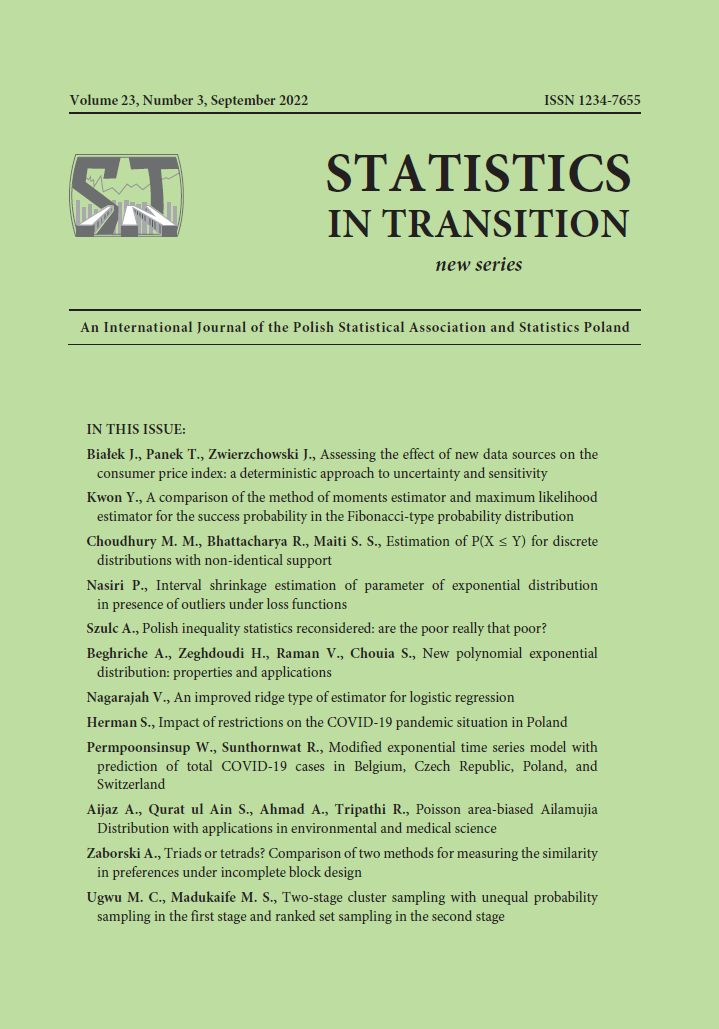ARTICLE
ABSTRACT
In the present study income inequality in Poland is evaluated using corrected income data to provide more reliable estimates. According to most empirical studies based on household surveys and considering the European standards, the recent income inequality in Poland is moderate and decreased significantly after reaching its peaks during the first decade of the 21st century. These findings were challenged by Brzeziński et al. (2022), who placed Polish income inequality among the highest in Europe. Such a conclusion was possible when combining the household survey data with information on personal income tax. In the present study the above-mentioned findings are further explored using 2014 and 2015 data and employing additional corrections to the household survey incomes. Incomes of the poorest people are replaced by their predictions made on a large set of well-being correlates, using the hierarchical correlation reconstruction. Applying this method together with the corrections based on Brzeziński’s et al. results reduces the 2014 and 2015 revised Gini indices, still keeping them above the values obtained with the use of the survey data only. It seems that the hierarchical correlation reconstruction offers more accurate proxies to the actual low incomes, while matching tax data provides better proxies to the top incomes.
KEYWORDS
inequality indices, household income imputation, income correlates
REFERENCES
Altman, E. I., (1968). Financial Ratios, Discriminant Analysis and the Prediction of the Corporate Bankruptcy. The Journal of Finance, Vol. 23, pp. 589–609.
Bartels, C., Metzing, M., (2019). An integrated approach for a top-corrected income distribution. Journal of Economic Inequality, Vol. 17, pp. 125–143.
Blanchet, T., Flores, I. and Morgan, M., (2018). The weight of the rich: Improving surveys using tax data. WID.world Working Paper Series No. 2018/12, World Inequality Lab, retrieved from https://pdfs.semanticscholar.org/71d4/c87af7224d185bdd9adee4ea22fcd1edc879.pdf
Brzeziński, M., Myck, M. and Najsztub, M., (2022). Sharing the gains of transition: Evaluating changes in income inequality and redistribution in Poland using combined survey and tax return data, forthcoming in European Journal of Political Economy.
Brzeziński, M., Najsztub, M., (2017). The impact of “Family 500+ programme on household incomes, poverty and inequality. Polityka Społeczna, Vol. 44, pp. 16–25.
Bussolo, M., Ferrer-I-Carbonell, Giolbas, A. and Torre, I., (2021). I perceive therefore I demand: the formation of inequality perceptions and demand for redistribution, Review of Income and Wealth, Vol. 67, pp. 835–871.
Cleveland, W. S., (1979). Robust locally weighted regression and smoothing scatterplots. Journal of the American Statistical Association, Vol. 74, pp. 829–836.
Cowell, F. A., Flachaire, E., (2007). Income distribution and inequality measurement: The problem of extreme values. Journal of Econometrics, Vol. 141, pp. 1044–1072.
Davern, M. E., Meyer, B. D. and Mittag, N. K., (2019). Creating improved survey data products using linked administrative-survey data. Journal of Survey Statistics and Methodology, Vol. 7, pp. 440–463.
Duda, J., (2018). Hierarchical correlation reconstruction with missing data, arXiv preprint, arXiv:1804.06218, retrieved from: https://arxiv.org/abs/1804.06218
Duda, J., Szulc, A., (2018). Credibility evaluation of income data with hierarchical correlation reconstruction, arXiv: 1812.08040, retrieved from: https://arxiv.org/abs/1812.08040
Duda, J., Szulc, A., (2020). Social benefits versus monetary and multidimensional poverty in Poland: imputed income exercise. In: Tsounis, N., Vlachvei, A. (eds.) Advances in cross-section data methods in applied economic research. ICOAE 2019. Springer Proceedings in Business and Economics. Springer.
Główny Urząd Statystyczny ? Statistics Poland, (2015). Budżety gospodarstw domowych ? Household budget survey, Warsaw.
Hlasny, V., Ceriani, L. and Verme, P., (2022)., Bottom incomes and the measurement of poverty and inequality, forthcoming in Review of Income and Wealth.
Jenkins, S. P., (2017). Pareto models, top incomes and recent trends in UK income inequality. Economica, Vo. 84, pp. 261–289.
Kasprzyk, D., (2005). Measurement error in household surveys: sources and measurement, in: Household Sample Surveys in Developing and Transition Countries, United Nations, New York.
Kośny, M., (2019). Upper tail of the income distribution in tax records and survey data. Evidence from Poland. Argumenta Oeconomica, Vol. 42, pp. 55–80.
Lepkowski, J., (2005). Non-observation error in household surveys in developing countries, in: Household Sample Surveys in Developing and Transition Countries, United Nations, New York.
Medeiros, M., De Castro Galvao, J. and De Azevedo Nazareno, L., (2018). Correcting the underestimation of top incomes: Combining data from income tax reports and the Brazilian 2010 census. Social Indicators Research, Vol. 135, pp. 233–244.
Michoń, P., (2021). Deservingness for "Family 500+" Benefit in Poland: Qualitative Study of Internet Debates, Social Indicators Research, Vol. 157, pp. 203–223.
Moore, J. C., Stinson, L. L. and Welniak, E. J., (2000). Income measurement error in surveys: A review. Journal of Official Statistics, Vol. 16, pp. 331–361.
Nicoletti, C., Peracchi, F. and Foliano, F., (2011). Estimating income poverty in the presence of missing data and measurement error. Journal of Business and Economic Statistics, Vol. 29, pp. 61–72.
Prawo i Sprawiedliwość – Law and Justice, (2015). Myśląc Polska 2015, proceedings of the conference, retrieved from: http://pis.org.pl/dokumenty?page=2
Panek, T., (2006). Multidimensional fuzzy relative poverty dynamic measures in Poland. In: Lemmi, A. and G. Betti (eds.), Fuzzy Set Approach to Multidimensional Poverty Measurement, Springer.
Pudney, S., Francavilla, F., (2006). Income mis-measurement and the estimation of poverty rates. An analysis of income poverty in Albania. ISER Working Paper 2006– 35. Colchester: University of Essex, retrieved from: https://www.iser.essex.ac.uk/research/publications/working-papers/iser/2006-35.pdf
